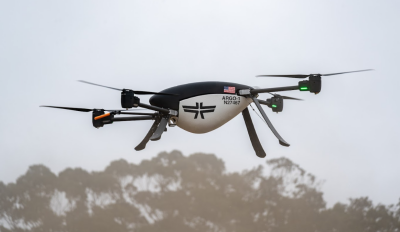Every new technology brings great opportunities and exciting possibilities, but simultaneously opens the door to threats and the opportunity for wrongdoing. UAVs are no exception, and the potential for drones being used for nefarious purposes has been something police agencies, federal, state and local governments have been considering for years now. Effectively combating these kinds of challenges can mean gathering critical info about the airspace and potentially taking action as a result, and a new counter UAV innovation allows organizations to do both.
On February 15, Fortem Technologies, Inc. announced the release of DroneHunter™, the first military-tested unmanned aircraft that provides perimeter intrusion detection and protection by patrolling a pre-determined airspace. Using AI algorithms, the DroneHunter system provides detection, monitoring and capture capabilities over restricted airspace or no-fly zones. Once a rogue drone is detected and captured, DroneHunter can tether and return, or safely fall back to to a predefined safe zone.The DroneHunter™ is an unmanned counter-UAS aircraft engineered to autonomously fly toward unwanted drones in the sky without a human pilot on the ground. It can detect, track, classify, monitor via video stream, inspect, and safely capture an intruder drone. The platform has an onboard autopilot and navigation system as well as optional 4K camera for real-time video, but these capabilities are just the beginning.“Drones are accessible to everyone now and are beginning to proliferate to enable many new services,“ said CEO of Fortem Technologies, Timothy Bean. “However, to fully embrace these benefits, we must monitor the airspace and secure no-fly zones. DroneHunter enables the benefits of a drone world to be realized.”Available today for defense and federal government customers, some of the technology inside the DroneHunter system was developed and hardened over several years on US Department of Defense applications and is now available on a wider basis. Core technologies include TrueView Radar, machine learning, specialized guidance, secure data collection and services as well as open command and control platforms for customers to detect, track, classify and mitigate unwanted drones. The open, secure ground station offers operational flexibility of multiple DroneHunters.Equipped with radar, DroneHunter includes an autonomous guidance system and an open command and control platform to detect, identify and tow away hostile drones within a secured geo-fenced perimeter. DroneHunter notifies authorized personnel of potential aerial threats in real-time. The command center ground station provides monitoring and manual intervention override options to meet situational requirements.With the proliferation of drones over our cities and the growing possibility of an attack or intrusion by hostile unmanned vehicles, efforts like DroneHunter makes the surveillance and defense of sensible targets ever more feasible and showcase why such capabilities will soon be a necessity.Subscribe
The information you submit will be stored and used to communicate with you about your interest in Commercial UAV News. To understand more about how we use and store information, please refer to our privacy policy.
February 16, 2018
Fortem Technologies Announces the First Fully Autonomous Counter UAV Solution















Comments